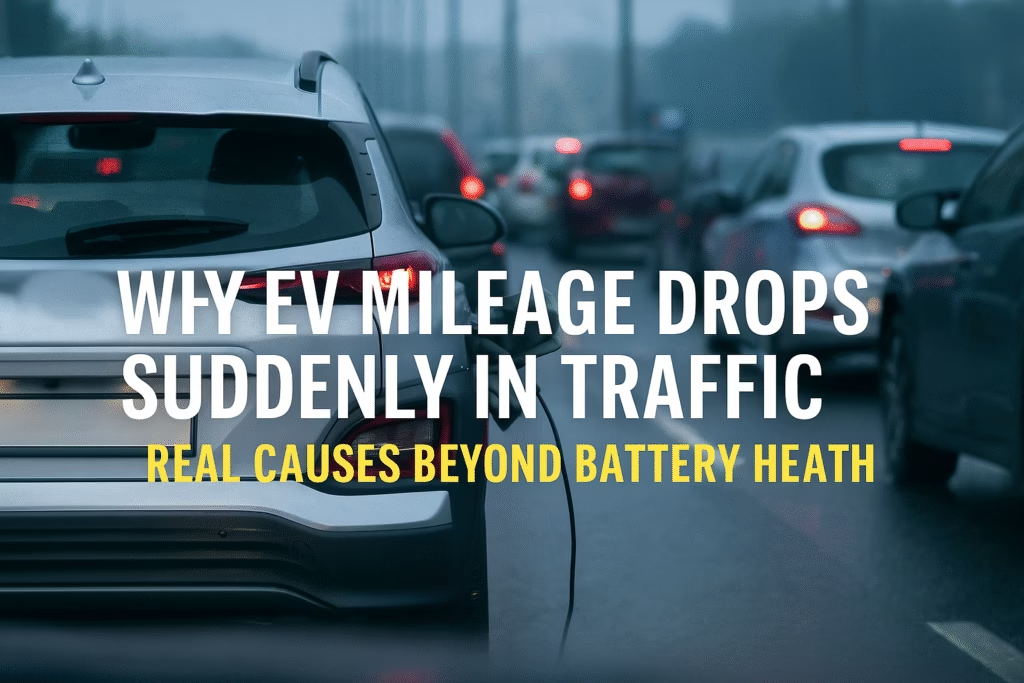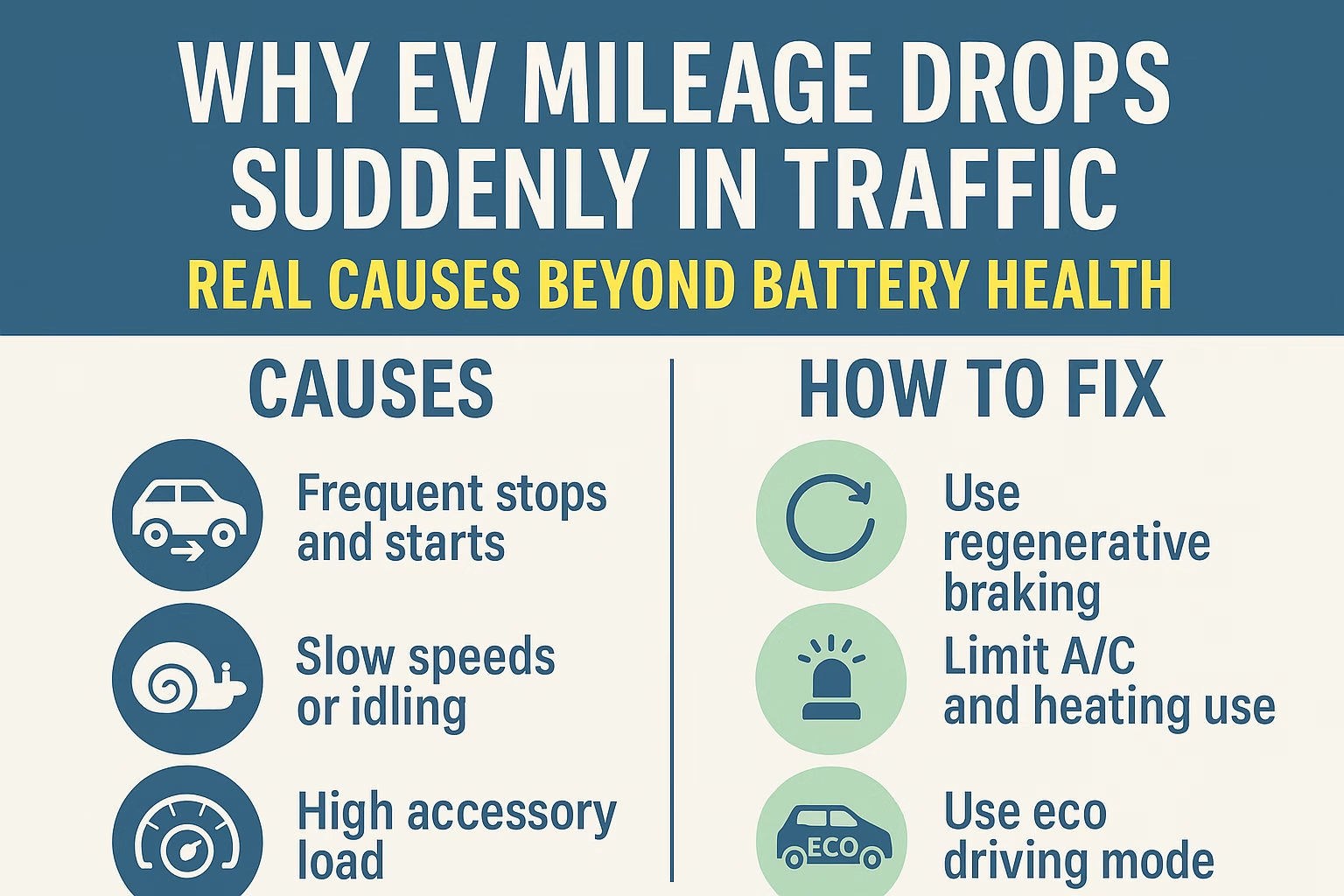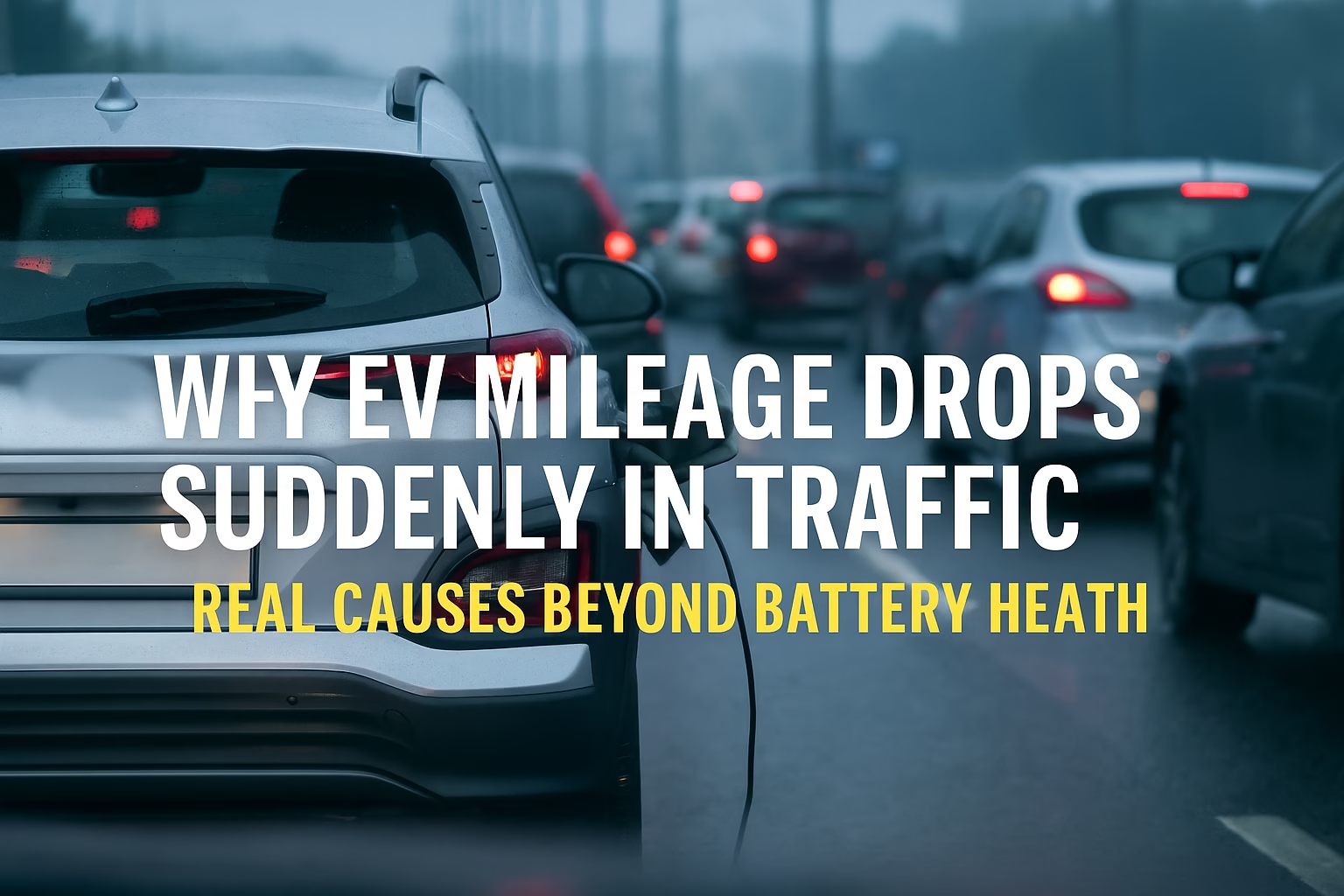Still, there’s a high chance you’ve experienced this. You’re driving through regular megacity traffic, and suddenly your EV range drops faster than hoped if you’re an EV holder in India. It’s not a battery issue, the rainfall is fine, and you are not speeding, so what is going on?

This article dives deep into the real causes of **EV mileage drop** that most manufacturers or service agents never tell you. We’ll break down each factor contributing to the sudden dip in range, explain why it’s especially common in Indian driving conditions, and offer fixes where possible.
🔍 What Is an EV Mileage Drop?
An **EV mileage drop** refers to a noticeable and frequently sudden reduction in the driving range of an electric vehicle. It can be sudden or gradual and is frequently more pronounced in stop-and-go traffic situations—exactly the kind of traffic Indian roads are known for.
Contrary to popular belief, a sudden **EV mileage drop** is not always a sign that your battery is maturing. There are **several real-world variables** that can bring up this issue even in a brand-new EV.
📉 Common Signs of EV Mileage Drop
Before we get into the causes, there are some symptoms that generally accompany a **sudden EV mileage drop**.
- Range estimate drops fleetly in traffic
- Battery percentage seems to deplete faster than usual
- Regenerative braking feels less effective
- The dashboard range does n’t match the real-world distance covered
- Your EV needs charging more frequently even with the same daily commute. Let’s now explore **what really causes these mileage drops**.
EV Charging Speed in India: Why Fast Charging Still Feels Slow Despite the Hype 2025
🚗 1. Traffic Means More Than Just Stops—It’s nonstop Drag
In thick Indian traffic, you aren’t just stopping and starting; you are also **moving slowly with constant minor accelerations**. This driving pattern means your EV motor is frequently pulling power from the battery without enough distance to justify it.
Unlike expressway driving, where speed is consistent and energy use is optimal, megacity driving creates **energy inefficiency**, leading to an **EV mileage drop** even within a short distance.
⚡ 2. Air Conditioning and Cabin Comfort in Hot Climates
India’s hot climate means most EV users run the AC all the time—especially in traffic where there is no airflow. Unlike petrol motor vehicles, **EVs power everything from the same battery**. The more your AC works, the more rapidly your battery drains.
A typical AC system can consume **1–2 kW of power per hour**, depending on the temperature setting. Over a 45-minute drive in heavy traffic, this can fluently shave off **10–15 of your battery range**, leading to an unexpected **EV mileage drop**.
🔋 3. Regenerative Braking Does n’t Work Well at Low Speeds
EVs are designed to recover energy during deceleration using **regenerative braking**, but this is far more effective at moderate or high speeds. In bumper-to-bumper traffic, **revival is minimal.
This means you are using energy to move the motor vehicle but not getting any of it back when you decelerate. Over time, this lack of recovery accumulates and manifests as a significant **EV mileage drop**.
🛣️ 4. Road Conditions: Potholes, Inclines, and Bumps
Indian megacity roads are infrequently smooth. **Constant changes in elevation**, potholes, and speed bumps mean your EV is constantly accelerating or climbing without momentum.
Even minor inclines in flyovers can **double the power consumption** for short durations. Repeating this pattern over many kilometers can lead to a shocking **EV mileage drop**, especially if your route includes poor roads or slopes.
📱 5. Background Systems and Poor Driving Apps
Numerous EVs now come with built-in apps that sync with your phone or pad to offer features like remote AC, live diagnostics, or live position tracking. These systems, though minimum in insulation, can **inclusively drain the battery** when you’re idle in traffic.
Also, some third-party navigation apps like Google Maps or Ola Driver use **high data and GPS polling rates**, which laterally increases power draw when the vehicle is in accessory or idle mode—another stealth contributor to **EV mileage drop**.
🚧 6. Tyre Pressure and Load – The Silent Battery Killers
Low tyre pressure can increase rolling resistance dramatically. A tyre underinflated by 10 can **reduce mileage by 3–5**. In real-life terms, that’s **10–15 km of lost range** on a 300 km EV.
Also, maximum Indian EVs constantly carry **spare passengers or weight**—something not completely optimized in the initial range estimates handed by manufacturers. That extra weight can directly result in a quick **EV mileage drop**.
🔌 7. Inconsistent Power Delivery in Older Infrastructure
In traffic jams, EVs may get stuck near high-electromagnetic zones like under metro lines, power substations, or massive cellular halls. These don’t harm your battery directly, but **they may interfere with sensors** used for telemetry and battery estimation.
This confusion in data occasionally causes the vehicle to **recalculate range downward**, showing an unexpected **EV mileage drop** even though the battery hasn’t actually drained as rapidly.
🛑 8. Sudden Braking Habits and Impulsive Acceleration
Numerous Indian drivers (especially in megacities) drive with a “go-fast-stop-hard” rhythm. This means **impulsive acceleration** even in short gaps and frequent braking.
Similar behavior not only limits regenerative braking effectiveness but also **uses up more energy than demanded**, leading to an early **EV mileage drop**, especially in traffic conditions where smoother driving could save 10–15 further power.
🔍 9. Over-Optimistic Range Estimates from Manufacturers
The claimed mileage of maximum EVs is grounded on **ideal conditions**: empty roads, no AC, a single passenger, optimal tyre pressure, and flat roads.
But your daily commute doesn’t equal that. So, when your real-world range is out by 20–30, **it’s not your battery’s fault**—it’s the **standard industry testing that is misleading**. That difference shows up as a **sudden EV mileage drop** in regular megacity driving.

✅ How to Fix or Reduce EV Mileage Drop
While you can’t control traffic, you *can* improve how your EV handles it. Here are some real results
- ** Plan Routes with Minimum Elevation ** Use maps that show elevation or use EV-focused route itineraries that prefer flatter roads.
- ** Use AC Smartly ** Set AC to eco mode or auto. Don’t run AC at full blast when the cabin is already cool.
- ** Maintain Tire Pressure ** Check your tyre pressure ** every week **, especially ahead of long commutes. Use nitrogen if available for further consistent pressure.
- ** Drive Smoothly ** Avoid rapid-fire accelerations or hard braking. Drive as if your battery meter is cash—because it is!
- ** Switch Off When Parked ** At long red lights or signals, if you are going to stay for more than 2 minutes, switch the car to park/off rather than idle.
- ** Update Software Regularly ** EVs admit OTA (over-the-air) updates. Make sure you’re on the latest software to benefit from optimized power usage algorithms.
📊 Real-World User Experiences in India
“I’ve a Tata Nexon EV, and my 220 km range frequently comes down to 160 km on bad traffic days. originally, I supposed my battery was defective, but after learning to drive more smoothly and using AC moderately, I’ve recovered 20–30 km in range. ”
— *Ashish M., Mumbai*
“In Bengaluru traffic, even a 10 km commute drops my range by 20–25 km. Regenerative braking just does n’t work well below 20 km//h.
— * Ritika S., Bengaluru *
These are real issues, and you are not alone in facing them.
🧠 Final Thoughts Know the Game Before You Blame the Battery
The next time you see an unexpected **EV mileage drop**, pause before assuming your battery is failing. In most cases, the battery is just fine—the inefficiencies lie in **how and where** you are using the car.
Understanding these hidden factors is key to becoming a smart EV holder. After all, it’s not just about charging fast—it’s about conserving energy smartly.
✅ Summary Checklist for EV Mileage Drop Fixes
- ✅ Keep tyre pressure optimal
- ✅ Use eco-mode for AC
- ✅ Avoid aggressive driving
- ✅ Use regenerative retardation wisely
- ✅ Plan low-elevation routes
- ✅ Update software regularly
Let’s figure out better habits and demand smarter range estimations, so your **EV mileage drop** no longer feels like a mystery but a soluble equation.


[…] Why EV Mileage Drops Suddenly in Traffic—Real Causes Beyond Battery Health […]